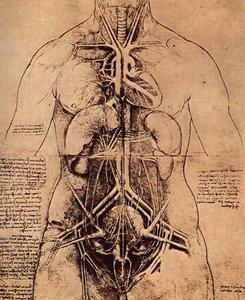Organs and Organ Systems

In the human body an organ is composed of two or more different histological types of tissue that work together to carry out a complex function. An organ system consists of a group of organs that perform intricate functions necessary for the survival of an organism. Sometimes an organism can survive with an impaired or nonfunctioning organ. However, when a whole system of organs shuts down, the life of the organism becomes compromised. Thus, the organ systems work together to maintain a constant internal environment called homeostasis within the body to ensure survival of the organism.
There are eleven organ systems within the human body: integumentary, skeletal, muscular, nervous, endocrine, circulatory, lymphatic, respiratory, digestive, urinary, and reproductive.
The integumentary system acts as a protective barrier for the human body against microorganisms, dehydration, and injuries caused by the outside environment. Additionally, the integumentary system regulates body temperature. Organs of the integumentary system include hair, nails, sebaceous glands, sudoriferous glands, and the largest organ of the body, the skin.
The skeletal system is a structural framework providing support, shape, and protection to the human body. Additionally, the skeletal system provides attachment sites for organs. The skeletal system also stores minerals and lipids and forms blood cells. Bones, cartilage, tendons, and ligaments are all organs of the skeletal system.
The muscular system provides movement to the human body as a whole as well as movement of materials through organs and organ systems. Additionally, the muscular system functions to maintain posture and produce heat. The muscular system consists of skeletal muscle, smooth muscle, and cardiac muscle.
The nervous system conducts electrical impulses throughout the body to regulate and control physiological processes of the other organ systems. Organs of the nervous system include the brain, spinal cord, and nerves.
The endocrine system also functions to regulate and control physiological processes of the body. However, the endocrine system accomplishes its functions by sending out chemical signals called hormones into the blood. Glands, the organs of the endocrine system, secrete hormones and include: pituitary gland, pineal gland, hypothalamus, thyroid gland, parathyroid glands, thymus, adrenal glands, pancreas, ovaries, and the testes.
The circulatory system circulates blood throughout the body and in doing so transports gases, nutrients, and wastes to and from tissues. Organs of the circulatory system include the heart, blood vessels, and blood.
The lymphatic system, also known as the immune system, defends the body against microorganisms and other foreign bodies. Additionally, the lymphatic system transports fluids from the body's tissues to the blood, thus helping to control fluid balance in the body. This system also absorbs substances from the digestive system. The organs of the lymphatic system include the lymph, lymph nodes, lymph vessels, thymus, spleen, and tonsils.
The respiratory system exchanges gases between the body's tissues and the external environment. Oxygen is inhaled from the external environment and passes from the lungs into the blood, where it is exchanged for carbon dioxide that passes from the blood to the lungs and is expelled. The respiratory system consists of the nose, pharynx, larynx, trachea, bronchi, and lungs.
The digestive system functions to digest and absorb nutrients from the food ingested into the body. Additionally, the digestive system transports foodstuff through the gastrointestinal tract. The primary organs of the digestive system include the mouth, pharynx, esophagus, stomach, small intestine, large intestine, rectum, and anal canal. Accessory organs that aid the primary organs include the teeth, salivary glands, tongue, liver, gallbladder, pancreas, and appendix.
The urinary system removes excess water and nutrients and filters wastes from the circulatory system. Additionally, the urinary system aids in red blood cell formation and metabolizes vitamin D. The urinary system's organs include the kidneys, ureters, urinary bladder, and urethra.
The reproductive system of the human body can be either male or female. The male reproductive system synthesizes gametes called spermatozoa that are responsible for fertilizing the female gametes, or oocytes, during reproduction. The female reproductive system is designed to undergo conception, gestation, and birth once a spermatozoon fertilizes an oocyte. The male reproductive system is composed of the testes, vas deferens, urethra, penis, scrotum, and prostate. The female reproductive system consists of the ovaries, uterus, fallopian tubes, vagina, vulva, and mammary glands.
See also Anatomy.
Resources
Books
Gray, Henry. Gray's Anatomy. Philadelphia: Lea & Febiger, 1992.
Martini, Frederic H., et al. Fundamentals of Human Anatomy & Physiology. Upper Saddle River, NJ: Prentice Hall, 2001.
Netter, Frank H. and Sharon Colacino. Atlas of the Human Body. Teterboro, NJ: Icon Learning Systems, 2003.
Other
Intellimed, Inc. "Human Anatomy Online-Innerbody.com" [cited March 10, 2003]. <http://www.innerbody.com/htm/body.html>.
Murray Jensen College, University Of Minnesota. "Web Anatomy" [cited March 10, 2003]. <http://www.gen.umn.edu/faculty_staff/jensen/1135/webanatomy/>.
Additional topics
Science EncyclopediaScience & Philosophy: Octadecanoate to Ovenbirds